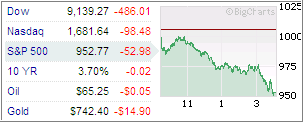 Hat tip to Random Roger, who referenced this WSJ article titled “No Place To Hide” in his blog a few days ago. It contains some interesting facts along with the usual dose of ignorance by the #1 buy-and-hold cheerleader Vanguard. Let’s listen in:
Hat tip to Random Roger, who referenced this WSJ article titled “No Place To Hide” in his blog a few days ago. It contains some interesting facts along with the usual dose of ignorance by the #1 buy-and-hold cheerleader Vanguard. Let’s listen in:
For months, many mutual-fund investors could take comfort in this: They had endured worse during the tech-stock collapse. The hard lessons learned from that earlier, harrowing ride led many to believe they were better positioned for this bear market.
But U.S. stock-market declines during October were so deep and wide that even tame investments were pummeled. Losses from the steep plunge that began just over a year ago now top those from 2000-2002.
The average diversified mutual fund of U.S. stocks returned a negative 18.7% in October, according to preliminary figures from fund tracker Lipper Inc.; as of Thursday, that average fund was down 40% since the Dow Jones Industrial Average hit a record high on Oct. 9, 2007. By comparison, during the previous bear market, between March 10, 2000, and the bottom on Oct. 9, 2002, the average diversified stock fund lost a total of 34.9%.
The past month has been a vivid reminder that sometimes, no matter how conservative an investor you think you are, you’re going to get hit. Those who sought havens in what were once considered the safest of stocks saw their holdings battered as fears of a serious recession mounted. Even those who shunned stocks for once-boring bond funds saw their portfolios dragged down as the ripples of the credit crisis expanded outward. There were few places to hide.
The average return for diversified U.S.-stock funds is a negative 34.7% for the first 10 months, which suggests 2008 is shaping up to be the worst year for mutual-fund investors in the nearly 50 years for which Lipper has such data.
By comparison, the Standard & Poor’s 500-stock index is down 32.8% so far this year and the Dow Jones Industrial Average is off 28.2%; the figures all include reinvested dividends.
Such losses sting all the more for a generation of investors who thought they had learned their lesson in the dot-com crash. Indeed, a list of the biggest 25 stock mutual funds and exchange-traded funds as of June 30 shows a decided tilt toward moderation and diversification — a big switch from the specialized tech funds that filled many investors’ portfolios in the late 1990s.
The 25 megafunds at midyear represent about a quarter of the money invested in more than 5,000 stock and stock-and-bond mutual funds and ETFs, according to industry executives. Five on the list are what Morningstar Inc. terms “allocation” funds, which try to reduce the effects of violent market swings by featuring a mix of bonds and stocks. Many of the funds also favor conservative holdings, like dividend-paying stocks, and are managed by firms widely regarded for their experience. Ten are from Capital Group Cos., whose American Funds family was begun in the Depression year of 1931.
But experience and moderation will get you only so far in the current climate on Wall Street. The biggest pure stock fund on the list, American Funds Growth Fund of America, which invests in traditional “growth” areas, such as technology and health care, and in “value”-oriented, dividend-paying stocks, is down 35% so far this year. The allocation funds are off by 24% to 30% since the start of the year. These were sideswiped by steeply falling prices of corporate, mortgage-backed and other types of bonds as investors fled to the relative safety of U.S. Treasurys. The average taxable U.S. bond fund has lost 9.8% so far this year, according to Lipper.
So far this year, even the two best-performing funds on the list, American Funds American Balanced and Vanguard Wellington, are both down 24%. And these are moderate-allocation funds — products for investors who prefer only a moderate amount of risk. Such funds typically have 50% to 70% of their assets in stocks and the remainder in fixed-income investments and cash.
…
Joe Brennan, director of portfolio review at Vanguard Group Inc., says he hopes small investors have the courage to ride out this period of turbulence. “This market has created tremendous opportunity for long-term investors because it’s been sort of indiscriminate selling,” says Mr. Brennan. There are bargains for investors who are willing to buy now, he says, adding, “The best investment decisions are generally unpopular and cut against human-behavior instincts.”
Read that last paragraph again. Brennan asks the small investor to “ride out this period of turbulence.” Of course, that’s the old Vanguard standby line. If investors were smart and had sold their holdings and moved to the sidelines before the serious drop happened, it would have a direct monetary effect on Vanguard’s bottom line.
The idea is to keep people invested no matter how much their mutual funds loses or how deep of a bear market we’re in; the #1 goal is to generate fees for the company. Whether you as the investor make money or not is unimportant.
That’s why you will never here anyone explain as to how long it takes for you to make up losses of 40% of your portfolio. The fact that you need to make some 66% on the balance just to get back to even, which will take many years of quality investing, is conveniently swept under the rug.
If this bear market plays out the way I think it will, it will (hopefully) have the potential to finally bury the senseless “strategy” of buy-and-hold forever.
 MarketWatch featured a piece called “Bottom Fishing.” The story mentions one mutual fund that for one brief shining moment last week showed a positive return for the year:
MarketWatch featured a piece called “Bottom Fishing.” The story mentions one mutual fund that for one brief shining moment last week showed a positive return for the year:





